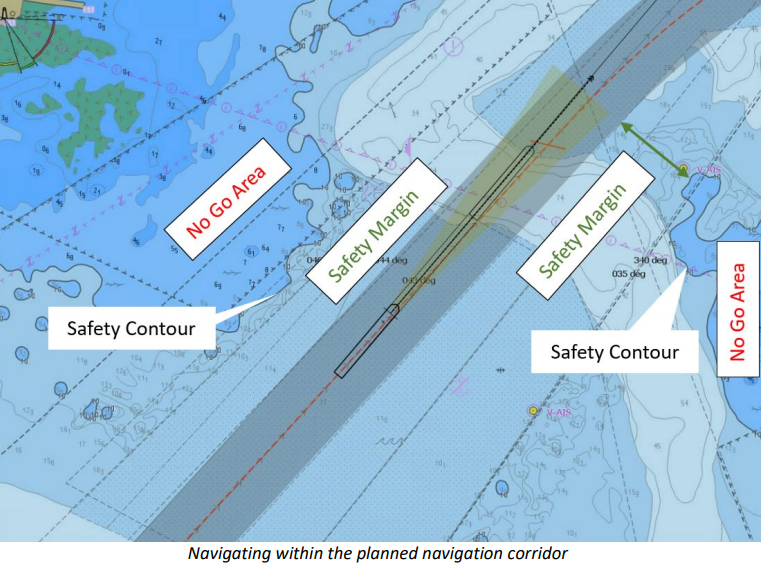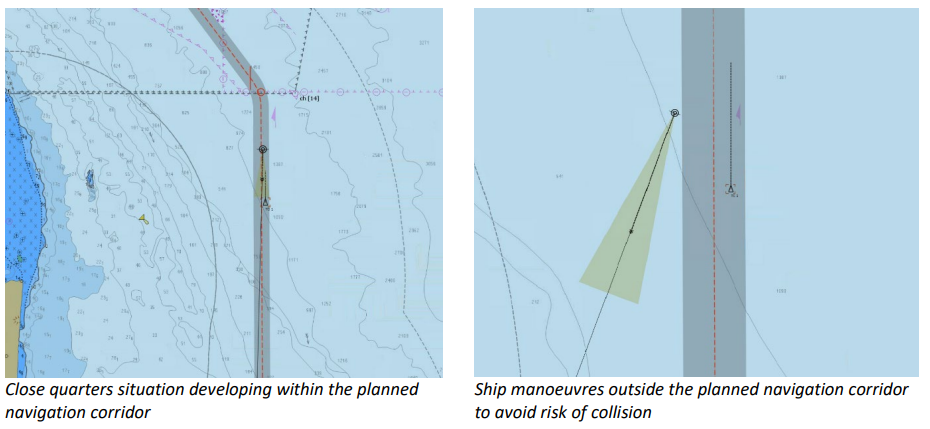The Australian Maritime Safety Authority (AMSA) has issued a circular to provide guidance on effective voyage planning and execution within planned navigation corridors.
The purpose of this guidance is to ensure that navigation corridors are used appropriately when planning on Electronic Chart Display and Information Systems (ECDIS). It emphasizes the importance of executing a voyage plan that has been approved by the ship’s Master within the planned navigation corridor, as far as is reasonably practicable.
Voyage planning with XTD/XTL (cross track distances or limits)
“Voyage and passage planning includes appraisal, i.e., gathering all information relevant to the contemplated voyage or passage; detailed planning of the whole voyage or passage from berth to berth, including those areas necessitating the presence of a pilot; execution of the plan; and the monitoring of the progress of the vessel in the implementation of the plan.” — IMO Guidelines for Voyage Planning (Res A.893(21)).
Having made a full appraisal of the intended voyage, a detailed passage plan is to be plotted on an ECDIS, factoring in the intended XTD/XTL from berth to berth for each leg. This determines the planned navigational corridor for each leg of the passage, electronically checked for charted hazards using the route check function. Specific dangers identified can then be considered and amended as necessary before the Master’s final approval of the overall passage plan and start of the voyage. When the bridge team is monitoring and executing the voyage, remaining within the planned navigation corridor minimizes workload by indicating pre-checked waters where the ship can safely navigate.

Navigating within the planned navigation corridor
The safety contour setting, set at the safety depth, defines a “No-Go” area where the ship may be in imminent danger and should avoid. This setting uses the closest available chart contour at least as deep as the entered setting. For example, if the chart has contours at 10m and 15m, and the safety contour setting is 11m, the safety contour on the chart will be the 15m contour. Depth soundings equal to or shallower than the safety depth will appear black and must always be avoided (soundings deeper than the safety depth are grey).
Guidance for departing from the planned navigation corridor into the safety margin
The voyage is expected to be executed according to the voyage plan and monitored to remain within the planned navigation corridor as far as is reasonably practicable. Any departure from the approved voyage plan must be carefully considered. The balance between the width of the planned navigational corridor and the safety margin should be determined for each leg of the voyage by considering:
- GNSS accuracy
- Vessel characteristics
- ENC’s Zone of Confidence (ZoC)
- Expected traffic conditions
Areas outside of the planned navigation corridor, up to the No-Go areas, are considered a safety margin available for unforeseen circumstances. Departing into the safety margin requires caution to maintain situational awareness, as this area has not been electronically verified or pre-checked. When using the safety margin, the bridge team should visually check and assess the ECDIS and discuss/agree on a plan to return to the navigation corridor as soon as possible. ECDIS look-ahead functionalities are essential in such cases.
For non-urgent deviations from the voyage plan, the Master should be consulted and the plan amended before leaving the planned navigation corridor. Recording the reasons for departing from the approved voyage plan will aid verification of sound navigation practices.
AMSA recognises the need for reasonable use of safety margins, but unreasonable or systematic use of safety margins may indicate the need to reassess voyage planning practices.

Close quarters situations developing within the planned navigation corridor
If a ship must manoeuvre outside the planned navigation corridor to avoid the risk of collision, this should be done with careful attention to the safety margin.
Port State Control (PSC) inspections
Voyage planning requirements, in accordance with SOLAS, are established in Australian legislation under Marine Order 27. A deficiency may be noted if a PSC Officer finds:
- Unreasonable and systematic use of the safety margins outside the planned navigation corridor
- No consideration of varying XTD/XTL depending on confined or open waters






























































Very good that you take this up. However, the Safety Margin between the planned corridor and the NO GO area is fully navigable waters and should be used if there is a need to deviate from the planned corridor.
This is explained in the article Sharing Mental Models in Confined Waters. https://www.csmartalmere.com/wp-content/uploads/2018/06/Sharing-Mental-Models-in-confined-waters-Seaways-June-2018-002.pdf
It seems to me that any deviation from route, for whatever reasons, should be within safety margin specified on a stage of passage planning, and there should be no any grey area requiring any new visual or other assessment.
I know that most of system unable to draw such safety margins along a route, however impossibility of it is caused by ECDIS limitations only. ECDIS standards not specifying requirements for system to maintain safety margins in a flexible manner, in a way of safety contour, according to wishes of passage planner, with anything else around becoming no go area. I witnessed birth of ECDIS, its struggle for implementation, and on completion of it have strong impression that current ECDIS standards became outdated long before system got approved. Today kids are playing on systems with performance far exceeding systems used for commercial navigation and problems described exists because of inefficiency of Agencies supposed to govern navigation.